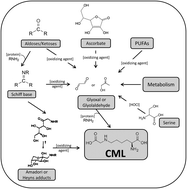Carboxymethyl-lysine: thirty years of investigation in the field of AGE formation
Abstract
In 1985 carboxymethyl-lysine (CML), the first glycoxidation product, was discovered by Dr Ahmed while trying to identify the major products formed in reactions of glucose with lysine under physiological conditions. From that moment, a significant number of researchers have joined efforts to study its formation routes both in foods and in living beings, and the possibility of the existence of an additive action between food-occurring and in vivo produced CML and to explore all the implications associated with its appearance in the biological systems, regardless of its origin. This review presents interesting information on the latest advances in the research on CML sources, mitigation strategies, intake, metabolism and body fluid and tissue delivery, its possible in vivo synergy with highly modified advanced glycation end products-protein, and the physio-pathological implications derived from the presence of this compound in body fluids and tissues.


 Please wait while we load your content...
Please wait while we load your content...